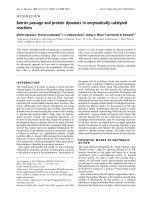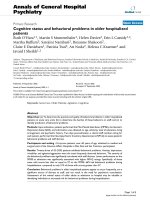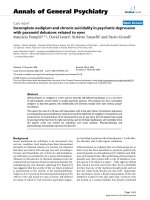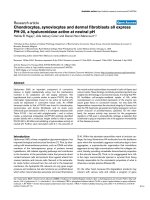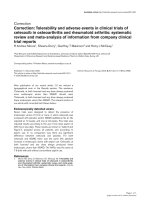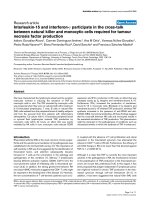Báo cáo y học: "Inflammatory mediators and cartilage biomarkers in synovial fluid after a single inflammatory insult: a longitudinal experimental study" pps
Bạn đang xem bản rút gọn của tài liệu. Xem và tải ngay bản đầy đủ của tài liệu tại đây (651.96 KB, 8 trang )
Open Access
Available online />Page 1 of 8
(page number not for citation purposes)
Vol 11 No 2
Research article
Inflammatory mediators and cartilage biomarkers in synovial fluid
after a single inflammatory insult: a longitudinal experimental
study
Janny C de Grauw
1
, Chris HA van de Lest
2
and Paul René van Weeren
1
1
Department of Equine Sciences, Faculty of Veterinary Medicine, Utrecht University, Yalelaan 114, 3584 CM, Utrecht, The Netherlands
2
Department of Biochemistry and Cell Biology, Faculty of Veterinary Medicine, Utrecht University, Yalelaan 2, 3584 CM, Utrecht, The Netherlands
Corresponding author: Janny C de Grauw,
Received: 5 Dec 2008 Revisions requested: 18 Jan 2009 Revisions received: 16 Feb 2009 Accepted: 9 Mar 2009 Published: 9 Mar 2009
Arthritis Research & Therapy 2009, 11:R35 (doi:10.1186/ar2640)
This article is online at: />© 2009 de Grauw et al.; licensee BioMed Central Ltd.
This is an open access article distributed under the terms of the Creative Commons Attribution License ( />),
which permits unrestricted use, distribution, and reproduction in any medium, provided the original work is properly cited.
Abstract
Introduction Inflammation is an important feature of many joint
diseases, and levels of cartilage biomarkers measured in
synovial fluid may be influenced by local inflammatory status.
Little is known about the magnitude and time course of
inflammation-induced changes in cartilage tissue turnover as
measured in vivo by synovial fluid markers. We aimed to study
temporal changes in concentrations of inflammatory mediators,
matrix metalloproteinase activity and cartilage biomarkers over 1
week in joints with experimentally induced inflammation.
Methods Localized inflammation was induced in the intercarpal
joint of six horses by sterile injection of 0.5 ng
lipopolysaccharide, and synovial fluid was collected at post-
injection hours (PIH) 0, 8, 24 and 168. Concentrations of
inflammatory mediators (prostaglandin E
2
, substance P, and
bradykinin), general matrix metalloproteinase activity and
markers of collagen II turnover (CPII and C2C) as well as
aggrecan turnover (CS846 and glycosaminoglycans) were
measured with appropriate assays. One-way analysis of
variance on repeated measures was used to analyze differences
in synovial fluid marker levels over time.
Results Lipopolysaccharide-injection led to a sharp rise in
prostaglandin E
2
at PIH 8, while substance P, bradykinin and
matrix metalloproteinase activity showed more sustained
increases at PIH 8 and 24. Glycosaminoglycan release
paralleled changes in the CS846 epitope, with an increase by
PIH 8, a peak at PIH 24, and return to baseline by PIH 168. For
type II collagen, a parallel time course between catabolic (C2C)
and anabolic (CPII) markers was also observed, but the time
course differed from that seen for proteoglycan markers:
collagen II markers peaked later, at PIH 24, and were still
elevated over baseline at PIH 168.
Conclusions A primary intra-articular inflammatory insult,
characterized by local release of peptide and lipid mediators and
matrix metalloproteinase activation, can alter synovial fluid levels
of proteoglycan biomarkers as early as 8 hours post-induction,
and can lead to sustained rises in collagen II biomarkers during
at least 1 week after onset.
Introduction
Inflammation is an important factor in the pathogenesis and
clinical presentation of equine joint disease as well as human
joint disease [1-3]. Overt joint inflammation as may be seen in
rheumatoid arthritis or infectious arthritis is known to have dev-
astating effects on the joint tissues, most importantly the artic-
ular cartilage, and in many joint disorders local release of
catabolic mediators plays an important role in the disruption of
cartilage matrix homeostasis [4].
Intra-articular inflammation can be studied in more detail by
means of analysis of proinflammatory cytokines, inflammatory
mediators and catabolic enzymes in synovial fluid (SF). Articu-
lar cartilage damage, whether inflammatory or traumatic in ori-
gin, can likewise be studied indirectly by means of SF
C2C: collagenase-cleavage neoepitope of type II collagen; CPII: carboxypropeptide of type II collagen; CS846: chondroitin sulfate epitope 846;
ELISA: enzyme-linked immunosorbent assay; GAG: glycosaminoglycans; IL: interleukin; LPS: lipopolysaccharide; MMP: matrix metalloproteinase;
PIH: post-injection hour; SF: synovial fluid; TNF: tumor necrosis factor.
Arthritis Research & Therapy Vol 11 No 2 de Grauw et al.
Page 2 of 8
(page number not for citation purposes)
biomarkers of cartilage matrix turnover [5]. The extracellular
matrix of articular cartilage is primarily made up of type II colla-
gen and aggrecan. Biomarkers reflecting aggrecan as well as
collagen II turnover have proven capable of signaling changes
in cartilage matrix homeostasis in various disease states [5-
10].
Of the many factors that may influence SF levels of cartilage
turnover markers other than accumulated damage to the artic-
ular cartilage, local inflammation may be among the most
important. Besides the potential dilution or washing-out of
these markers due to joint effusion and/or altered clearance
rates [11,12], there may be direct effects of inflammatory
mediators and enzymes on articular cartilage turnover and thus
on cartilage biomarker levels [13,14]. Few studies have so far
attempted to quantify the effects of intra-articular inflammation
on SF biomarker levels without the confounding effect of pre-
vious disease or concurrently created mechanical cartilage
damage at baseline.
The horse is both a target animal for arthritis research and a
suitable large animal model for the study of joint and cartilage
disorders in humans [15-17]. In addition to having proportion-
ately large joints from which ample SF can be obtained without
the need for lavage or anesthesia [16], the horse is unique in
that the pathophysiology of equine arthritis has been well stud-
ied for decades [18]. In horses, intra-articular lipopolysaccha-
ride (LPS) injection in nanogram quantities is an established
model for induction of transient localized sterile inflammation,
which has been used to study clinical symptoms and gait
parameters, drug pharmacokinetics, and/or the effects of ther-
apeutic intervention [19-22].
The current study used this LPS model to investigate the influ-
ence of a single inflammatory insult on a panel of SF mediators
and markers over the time course of 1 week. The panel
included several inflammatory mediators and enzymes impli-
cated in altered joint homeostasis in arthritic disease (prostag-
landin E
2
, substance P, bradykinin, matrix metalloproteinase
(MMP) activity), as well as turnover markers of aggrecan
(chondroitin sulfate epitope 846 (CS846) and gly-
cosaminoglycans (GAG)) and collagen II (carboxypropeptide
of type II collagen (CPII) and collagenase-cleavage
neoepitope of type II collagen (C2C)). We found that lipid and
peptide inflammatory mediators and MMP activity show an
early rise within 8 hours of induction of inflammation, with con-
comitant transient increases in aggrecan turnover markers
within the first 24 hours. Collagen II turnover markers showed
a similar parallel time course between catabolic and anabolic
markers, but their response was delayed (starting at 24 hours),
and persisted 1 week after induction of inflammation.
Materials and methods
Experimental animals
All experimental procedures and protocols were pre-approved
by the Utrecht University Committee on the Care and Use of
Experimental Animals in compliance with Dutch legislation on
laboratory animal use. Six skeletally mature warmblood mares
between 5 and 8 years of age with no history of orthopedic
disease, free of lameness and with clinically and radiographi-
cally normal carpal joints were selected for this study. Horses
were allowed a 2-week acclimatization period with once-daily
hand-walking and were box-rested in separate 3.6 × 3.6 m
2
stalls on woodchip bedding for the duration of the experiment.
Induction of inflammation
At post-injection hour (PIH) 0, one randomly assigned carpus
of each horse was clipped and prepared for dorsal arthrocen-
tesis. Lipopolysaccharide from Escherichia coli O55:B5 (cat-
alogue number L5418, lot 057K4106; Sigma-Aldrich, St
Louis, MO, USA) was diluted to a final concentration of 0.625
ng/ml in sterile lactated Ringer's solution. Horses were
sedated with detomidine (0.01 mg/kg intravenously, Domose-
dan
®
; Pfizer, Capelle a/d IJssel, the Netherlands) and metha-
done (0.1 mg/kg intravenously; Eurovet Animal Health, Bladel,
the Netherlands). Arthrocentesis was performed with a 21 G
× 40 mm needle and 0.8 ml LPS solution was delivered asep-
tically into the intercarpal joint after withdrawal of the PIH 0 SF
sample.
Assessment of clinical outcomes
Before arthrocentesis at PIH 0, every 2 hours between PIH 2
and PIH 8, and at PIH 8, 24, 48 and 168, each horse's atti-
tude, temperature, pulse and respiratory rate were recorded,
lameness was scored on a standardized 0 to 5 scale [23],
intercarpal joint effusion was graded on a scale from 0 to 4 as
previously described [24], and carpal circumference was
measured at the level of the accessory carpal bone with a tape
measure. All scores were assigned and recorded by the same
observer (JCdG).
Collection of blood and synovial fluid
Blood was collected from the left jugular vein for routine hema-
tology before sedation for arthrocentesis at PIH 0, 8, 24 and
168. Part of each SF sample was placed in ethylenediamine
tetraacetic acid tubes for macroscopic evaluation, routine SF
total white blood cell count with differentiation and total pro-
tein measurement (refractometer), while the remainder was
centrifuged in plain tubes at 13,000 rpm for 15 minutes, aliq-
uotted and stored at -80°C until further analysis.
Synovial fluid mediator and marker analysis
A total of eight assays were performed on each SF sample.
The prostaglandin E
2
concentration was measured by a com-
mercial ELISA (RnDsystems, Minneapolis, MN, USA) following
RP-18 extraction of SF samples [25]. All peptide marker
assays were performed in the presence of 1 mM (final
Available online />Page 3 of 8
(page number not for citation purposes)
concentration) phenylmethylsulphonylfluoride (an inhibitor of
serine proteases). Substance P and bradykinin were meas-
ured using commercial enzyme immunoassay kits (substance
P kit from Cayman Chemical, Ann Arbor, MI, USA; and brady-
kinin kit from Bachem, Bubendorff, Switzerland).
General MMP activity was measured by means of a fluorimet-
ric assay based on cleavage of the fluorogenic peptide sub-
strate FS-6 (Calbiochem, San Diego, CA, USA). This
substrate was previously shown to be considerably more sen-
sitive than FS-1 for measuring activity of collagenases (MMP1,
MMP8, MMP13) in biological fluids [26]. In short, to 20 l SF
were added 80 l MMP buffer (0.1 M Tris, 0.1 M NaCl, 10 mM
CaCl
2
, 0.05% (w/v) Triton X-100, 0.1% (w/v) PEG6000, pH
7.5) and 100 l of 10 M FS-6 solution, after which the fluo-
rescent signal was monitored for 10 minutes. The slope of the
resultant linear curve (relative fluorescence units/second) was
calculated as a measure of general MMP activity.
GAG release was quantified by the 1,9-dimethylmethyleneb-
lue assay, adapted for use in microtiter plates [25]. Concentra-
tions of the CS846 epitope (a putative marker of aggrecan
synthesis [27,28]), as well as of CPII (a marker of type II colla-
gen synthesis [29]) and C2C (a neoepitope present on colla-
genase-cleavage fragments of type II collagen [30,31]) were
measured using commercial ELISA kits (IBEX, Montreal, Que-
bec, Canada). All of these assays were previously validated for
use in the horse [25,32].
Statistical analysis
Data are presented as the mean ± standard error of the mean.
The effect of time after induction of inflammation on concentra-
tions of SF parameters was tested by use of one-way analysis
of variance on repeated measures. When a significant time
effect was observed, levels at individual time points were com-
pared with Tukey's post hoc tests. Categorical clinical varia-
bles were compared over time using a Friedman test, followed
by Dunn's post hoc tests. Computer software was used
Figure 1
Clinical effects of lipopolysaccharide-induced joint inflammationClinical effects of lipopolysaccharide-induced joint inflammation. (a) Lameness grade, (b) effusion score and (c) carpal circumference following
induction of synovitis in the intercarpal joints of horses (n = 6). Inflammation was induced at t = 0 by intra-articular injection of 0.5 ng Escherichia coli
lipopolysaccharide. Data presented as the mean ± standard error of the mean. *P < 0.05, **P < 0.01, ***P < 0.001 compared with baseline (t = 0).
Arthritis Research & Therapy Vol 11 No 2 de Grauw et al.
Page 4 of 8
(page number not for citation purposes)
(GraphPad Prism version 4.00 for Windows; GraphPad Soft-
ware, San Diego, CA, USA) and the level of significance was
set at P < 0.05.
Results
Clinical assessment
LPS injection led to a significant rise in lameness and effusion
scores and carpal circumference (Figure 1). The lameness
score was no longer significantly different from 0 at PIH 24
and lameness had resolved by PIH 48 in all six horses, while
joint effusion showed a more gradual decline. No changes in
appetite, pulse or respiration were observed, and rectal tem-
perature and hematological variables remained within normal
limits (data not shown).
Conventional synovial fluid parameters
The results of routine SF analyses are presented in Table 1.
Synovial fluid mediators and markers
Induction of inflammation led to a sharp rise in prostaglandin
E
2
at PIH 8, while substance P, bradykinin and MMP activity
showed more sustained increases at PIH 8 and 24 (Figure 2).
GAG release and the CS846 epitope showed parallel
changes after LPS injection. Both were already significantly
elevated by PIH 8, peaked at PIH 24, and returned to baseline
levels by PIH 168 (Figure 3). For type II collagen, parallel pro-
files of putative catabolic (C2C) and anabolic (CPII) markers
over time were also observed, but the time course differed
from that seen for aggrecan markers in that collagen II markers
rose later, at PIH 24, and were still elevated over baseline at
PIH 168 (Figure 4).
Discussion
Over the past decades, the importance of intra-articular inflam-
mation in joint pain, joint effusion and progression of cartilage
damage has become increasingly appreciated [2,33], as has
the usefulness of synovial fluid biomarkers for monitoring dis-
ease progression or therapeutic response [5]. The magnitude
and timing of the effects of active inflammation on SF biomar-
ker levels, however – although acknowledged by many before
– have received relatively little formal attention.
The inflammatory response elicited in the present study by
intra-articular injection of 0.5 ng LPS was overt but also highly
transient, and the absence of systemic signs of endotoxemia
confirmed the local nature of LPS effects. The clinical
response to LPS and changes in routine SF parameters
closely paralleled those documented previously [21,22], con-
firming reproducibility of this model for induction of severe but
transient joint inflammation.
We further characterized the induced inflammatory response
through SF analysis of inflammatory mediators and pain-
related (neuro)peptides. The observed increase in prostaglan-
din E
2
was sharp and short-lived, which agrees with previous
studies [19,34]. The involvement of bradykinin and substance
P in this model is a novel finding; from studies on LPS-medi-
ated effects in rodents, we hypothesized that LPS would
indeed induce bradykinin and substance P release [35,36].
Owing to the descriptive nature of the present study and the
known interactions between prostaglandin E
2
, substance P
and MMP activity, we cannot determine to what extent
changes in cartilage markers were due to each individual
mediator. The observed increases in these mediators, how-
ever, do implicate each of them in the synovial inflammatory
process, and they all may have contributed to the accompany-
ing changes in cartilage turnover markers. While prostaglandin
E
2
and substance P are known actors in cartilage degradation
in arthritic joints [3,37], the effects of bradykinin on articular
cartilage remain largely unknown [38]. Certainly, our findings
warrant further investigation of the involvement of each of
these mediators and their receptors in altered cartilage turno-
ver in arthritis.
The rise in prostaglandin E
2
, bradykinin and substance P in the
first 24 hours coincided with an increase in MMP activity at
PIH 8 and 24. The fluorogenic substrate used shows
enhanced sensitivity for collagenase-mediated (MMP1,
MMP8, MMP13) cleavage, but may also be cleaved by TNF
converting enzyme [26]. Unfortunately, activity assays that uti-
lize capture antibodies for specific MMP subtypes have not yet
been developed for use in the horse, so no inferences regard-
ing activities of individual MMPs are justified.
Table 1
Results of conventional synovial fluid analysis following intra-articular injection of 0.5 ng lipopolysaccharide
Time after lipopolysaccharide
0 hours 8 hours 24 hours 168 hours
Total protein (g/dl) 1.27 ± 0.18 4.70* ± 0.18 4.80* ± 0.14 1.53 ± 0.18
Leucocytes (x10
9
cells/l) 0.25 ± 0.085 215.4* ± 15.9 64.6*,
†
± 6.7 0.72 ± 0.38
Neutrophils (%) N/A 98.8* ± 0.31 80.0*,
†
± 3.4 N/A
Comparison of synovial fluid total protein, white blood cell counts and differentiation over time after induction of joint inflammation. Data
correspond to the mean ± standard error of the mean (n = 6 horses). N/A, no differentiation performed given low white blood cell counts.
*Significant difference from PIH 0 and 168 (P < 0.001).
†
Significant difference from PIH 8 (P < 0.001).
Available online />Page 5 of 8
(page number not for citation purposes)
LPS injection resulted in a swift and transient response of
aggrecan turnover markers, both CS846 epitope and GAG
release rising within 8 hours of LPS injection and returning to
baseline after 1 week. This agrees with previously docu-
mented early increases in the release of aggrecan fragments
from cartilage in response to injury or inflammatory stimuli
[39,40]. Concentrations of the CS846 epitope in synovial
fluid, proposed to reflect the turnover of novel aggrecan mole-
cules [27,28], showed a strikingly similar time course to GAG
levels following induction of inflammation. As both markers
returned to baseline within 1 week, this inflammation-induced
enhancement of aggrecan turnover seems to be both a fast
and short-lived phenomenon.
A parallel course like that seen for aggrecan turnover markers
was also evident for collagen II; however, the response of col-
lagen II markers to LPS injection was delayed (at PIH 24) and
persisted longer, with levels of both anabolic (CPII) and cata-
bolic (C2C) markers still being elevated over baseline at PIH
168. This time lag between changes in aggrecan and collagen
II markers in SF coincides with that seen in cartilage extracts
in the rat mono-iodoacetate model of arthritis [41]. Concomi-
tant with a rise in C2C at PIH 24 and 168, indicating inflam-
mation-induced enhancement of collagen II cleavage [9], we
found elevated concentrations of CPII. Increases in SF CPII
levels have also been noted in human osteoarthritis and rheu-
matoid arthritis patients, as well as in animal models of oste-
oarthritis [7,17,29]. The increase in CPII following joint injury
or with osteoarthritis development has generally been inter-
preted as a reparative response intended to mend damage to
the collagen network. The current data indicate that a single
transient inflammatory insult can also induce sustained
changes in SF CPII levels over 1 week.
There are some limitations to the current study. The use of nor-
mal horses and a transient inflammatory stimulus may limit
Figure 2
Synovial fluid inflammatory mediators and matrix metalloproteinase activity in inflamed jointsSynovial fluid inflammatory mediators and matrix metalloproteinase activity in inflamed joints. Synovial fluid (SF) levels of (a) prostaglandin E
2
(PGE
2
),
(b) substance P, (c) bradykinin, and (d) general matrix metalloproteinase (MMP) activity over time in inflamed intercarpal joints of horses (n = 6).
Inflammation was induced at t = 0 by intra-articular injection of 0.5 ng Escherichia coli lipopolysaccharide. Data presented as the mean ± standard
error of the mean. *P < 0.05, **P < 0.01, ***P < 0.001. RFU/s, relative fluorescence units/second.
Arthritis Research & Therapy Vol 11 No 2 de Grauw et al.
Page 6 of 8
(page number not for citation purposes)
extension of the results to diseased individuals with more
chronic inflammation. The choice of the LPS model for induc-
tion of joint inflammation was based on it having been well
studied in the horse [19,21,22], showing reproducible local
effects with accurate timing and quick recovery of joints. In
addition, LPS is known to induce IL-1 and various other
cytokines and mediators, such as TNF and prostaglandin E
2
,
implicated in naturally occurring arthritis [34,42-44]. Injection
of LPS (or any other inflammatory stimulus) into a joint will elicit
a release of inflammatory mediators from both the synovial
membrane and the articular cartilage, which may affect carti-
lage integrity and thus SF marker levels. Apart from this indi-
rect pathway, a direct effect of LPS on chondrocyte gene
transcription cannot be excluded. No discrimination can be
made between both effects on SF markers, but any significant
direct LPS effect can be considered very small, given the dos-
age used [22].
The lack of visualization of the articular cartilage unfortunately
precludes a direct appreciation of the effects of LPS-induced
Figure 3
Synovial fluid levels of aggrecan turnover markers in inflamed jointsSynovial fluid levels of aggrecan turnover markers in inflamed joints. Synovial fluid concentrations of (a) glycosaminoglycans (GAG) and (b) chon-
droitin sulfate epitope 846 (CS846) over time in inflamed intercarpal joints of horses (n = 6). Inflammation was induced at t = 0 by intra-articular
injection of 0.5 ng Escherichia coli lipopolysaccharide. Data presented as the mean ± standard error of the mean. *P < 0.05, **P < 0.01, ***P <
0.001.
Figure 4
Synovial fluid levels of collagen II turnover markers in inflamed jointsSynovial fluid levels of collagen II turnover markers in inflamed joints. Synovial fluid concentrations of (a) collagenase-cleavage neoepitope of type II
collagen (C2C) and (b) carboxypropeptide of type II collagen epitope (CPII) over time in inflamed intercarpal joints of horses (n = 6). Inflammation
was induced at t = 0 by intra-articular injection of 0.5 ng Escherichia coli lipopolysaccharide. Data presented as the mean ± standard error of the
mean. *P < 0.05, **P < 0.01, ***P < 0.001.
Available online />Page 7 of 8
(page number not for citation purposes)
inflammation on the cartilage in the current set-up. Sacrifice of
horses and analysis of cartilage at PIH 168, however, was
beyond the scope of the current study, especially as we
expected changes in marker levels to have returned to base-
line by this time. In retrospect, it would have been interesting
to extend the period of inflammation and SF collection, and to
include a direct evaluation of the articular cartilage at baseline
as well as at study completion, since this would have allowed
us to assess the predictive value of SF marker concentrations
for the level of cartilage damage incurred.
No sham-injected contralateral joints were included in the cur-
rent study for comparison of the effect of repeated arthrocen-
tesis alone on SF marker levels versus the effect of LPS;
however, multiple studies have previously shown the effects of
LPS on SF parameters to far exceed that of saline injection,
and thus probably that of arthrocentesis alone [19,34]. Lastly,
SF marker concentrations reported here were not corrected
for dilution effects due to joint effusion using blood:SF urea
ratios as suggested previously [12]. As LPS produced con-
sistent joint effusion, the reported rises in marker concentra-
tions will be an underestimate rather than an overestimate, and
hence the observed trends and validity of conclusions drawn
will be unaffected by correction.
Conclusions
We have demonstrated pronounced effects of a single epi-
sode of joint inflammation on SF inflammatory mediators, MMP
activity and cartilage biomarkers in healthy joints. In short,
prostaglandin E
2
, substance P, bradykinin and MMP activity
rise shortly after induction of inflammation; both markers of
aggrecan and collagen II turnover increase in response to tran-
sient inflammation; putative anabolic and catabolic markers for
each of these matrix components rise simultaneously; and the
rise in collagen II turnover markers occurs slightly later than
that of aggrecan markers, and persists longer. While the exten-
sion of these data to the clinical situation requires caution
given the above limitations of the current model, the present
study shows that a single event producing significant intra-
articular inflammation may have a prolonged effect on SF con-
centrations of markers of cartilage turnover.
Competing interests
The authors declare that they have no competing interests.
Authors' contributions
JCdG participated in the study design, carried out the experi-
mental procedures, performed the mediator and marker
(immuno)assays and drafted the manuscript. CHAvdL pro-
vided technical support with the synovial fluid analyses, per-
formed the statistical analysis, and assisted in manuscript
preparation. PRvW conceived of the study, participated in its
design and coordination, and helped draft the manuscript. All
authors read and approved the final manuscript.
Acknowledgements
The authors would like to indicate that the data presented in this manu-
script are part of a larger study investigating the effects of oral adminis-
tration of a nonsteroidal anti-inflammatory drug on synovial fluid
inflammatory parameters and cartilage biomarkers in inflamed equine
joints. That study was partly funded by Boehringer Ingelheim Vetmedica
(Alkmaar, the Netherlands); however, the funding agreement explicitly
covered only those data that were directly related to treatment effects of
the nonsteroidal anti-inflammatory drug under investigation. The funding
source of the overall study therefore has no relation to the data pre-
sented in the current manuscript. The authors would also like to express
their sincere gratitude to Ms Marjory Pollak for her invaluable help in
sample collection and storage.
References
1. Loeuille D, Chary-Valckenaere I, Champigneulle J, Rat AC, Tous-
saint F, Pinzano-Watrin A, Goebel JC, Mainard D, Blum A, Pourel
J, Netter P, Gillet P: Macroscopic and microscopic features of
synovial membrane inflammation in the osteoarthritic knee:
correlating magnetic resonance imaging findings with disease
severity. Arthritis Rheum 2005, 52:3492-3501.
2. Hill CL, Hunter DJ, Niu J, Clancy M, Guermazi A, Genant H, Gale
D, Grainger A, Conaghan P, Felson DT: Synovitis detected on
magnetic resonance imaging and its relation to pain and carti-
lage loss in knee osteoarthritis. Ann Rheum Dis 2007,
66:1599-1603.
3. Sutton S, Clutterbuck A, Harris P, Gent T, Freeman S, Foster N,
Barrett-Jolley R, Mobasheri A: The contribution of the synovium,
synovial derived inflammatory cytokines and neuropeptides to
the pathogenesis of osteoarthritis. Vet J 2009, 179:10-24.
4. Scott-Lennox JA, McLaughlin-Miley C, Lennox RD, Bohlig AM, Cut-
ler BL, Yan C, Jaffe M: Stratification of flare intensity identifies
placebo responders in a treatment efficacy trial of patients
with osteoarthritis. Arthritis Rheum 2001, 44:1599-1607.
5. Bauer DC, Hunter DJ, Abramson SB, Attur M, Corr M, Felson D,
Heinegard D, Jordan JM, Kepler TB, Lane NE, Saxne T, Tyree B,
Kraus VB, Osteoarthritis Biomarkers Network: Classification of
osteoarthritis biomarkers: a proposed approach. Osteoarthr
Cartil 2006, 14:723-727.
6. Matyas JR, Atley L, Ionescu M, Eyre DR, Poole AR: Analysis of
cartilage biomarkers in the early phases of canine experimen-
tal osteoarthritis. Arthritis Rheum 2004, 50:543-552.
7. Lohmander LS, Yoshihara Y, Roos H, Kobayashi T, Yamada H,
Shinmei M: Procollagen II C-propeptide in joint fluid: changes
in concentration with age, time after knee injury, and
osteoarthritis. J Rheumatol 1996, 23:1765-1769.
8. Henrotin Y, Addison S, Kraus V, Deberg M: Type II collagen
markers in osteoarthritis: what do they indicate? Curr Opin
Rheumatol 2007, 19:444-450.
9. Fraser A, Fearon U, Billinghurst RC, Ionescu M, Reece R, Barwick
T, Emery P, Poole AR, Veale DJ: Turnover of type II collagen and
aggrecan in cartilage matrix at the onset of inflammatory
arthritis in humans: relationship to mediators of systemic and
local inflammation. Arthritis Rheum 2003, 48:
3085-3095.
10. Ishiguro N, Ito T, Oguchi T, Kojima T, Iwata H, Ionescu M, Poole
AR: Relationships of matrix metalloproteinases and their
inhibitors to cartilage proteoglycan and collagen turnover and
inflammation as revealed by analyses of synovial fluids from
patients with rheumatoid arthritis. Arthritis Rheum 2001,
44:2503-2511.
11. Myers SL, Brandt KD, Eilam O: Even low-grade synovitis signif-
icantly accelerates the clearance of protein from the canine
knee. Implications for measurement of synovial fluid 'markers'
of osteoarthritis. Arthritis Rheum 1995, 38:1085-1091.
12. Kraus VB, Huebner JL, Fink C, King JB, Brown S, Vail TP, Guilak F:
Urea as a passive transport marker for arthritis biomarker
studies. Arthritis Rheum 2002, 46:420-427.
13. Poole AR: An introduction to the pathophysiology of
osteoarthritis. Front Biosci 1999, 4:D662-D670.
14. Garnero P, Delmas PD: Biomarkers in osteoarthritis. Curr Opin
Rheumatol 2003, 15:641-646.
Arthritis Research & Therapy Vol 11 No 2 de Grauw et al.
Page 8 of 8
(page number not for citation purposes)
15. Koch TG, Betts DH: Stem cell therapy for joint problems using
the horse as a clinically relevant animal model. Expert Opin
Biol Ther 2007, 7:1621-1626.
16. Laverty S, Sandy JD, Celeste C, Vachon P, Marier JF, Plaas AH:
Synovial fluid levels and serum pharmacokinetics in a large
animal model following treatment with oral glucosamine at
clinically relevant doses. Arthritis Rheum 2005, 52:181-191.
17. Frisbie DD, Ghivizzani SC, Robbins PD, Evans CH, McIlwraith
CW: Treatment of experimental equine osteoarthritis by in
vivo delivery of the equine interleukin-1 receptor antagonist
gene. Gene Ther 2002, 9:12-20.
18. McIlwraith CW: General pathobiology of the joint and response
to injury. In Joint Disease in the Horse Edited by: McIlwraith CW,
Trotter GW. Philadelphia: W.B. Saunders; 1996:40-70.
19. Morton AJ, Campbell NB, Gayle JM, Redding WR, Blikslager AT:
Preferential and non-selective cyclooxygenase inhibitors
reduce inflammation during lipopolysaccharide-induced
synovitis. Res Vet Sci 2005, 78:189-192.
20. Khumsap S, Lanovaz JL, Rosenstein DS, Byron C, Clayton HM:
Effect of induced unilateral synovitis of distal intertarsal and
tarsometatarsal joints on sagittal plane kinematics and kinet-
ics of trotting horses. Am J Vet Res 2003, 64:1491-1495.
21. Meulyzer M, Vachon P, Beaudry F, Vinardell T, Richard H, Beau-
champ G, Laverty S: Joint inflammation increases glucosamine
levels attained in synovial fluid following oral administration of
glucosamine hydrochloride. Osteoarthritis Cartilage 2009,
17:228-234.
22. Palmer JL, Bertone AL: Experimentally-induced synovitis as a
model for acute synovitis in the horse. Equine Vet J 1994,
26:492-495.
23. Ross MW: The lameness score: quantification of lameness
severity. In Diagnosis and Management of Lameness in the
Horse Edited by: Ross MW, Dyson SJ. Philadelphia: W.B.
Saunders; 2003:66-67.
24. Owens JG, Kamerling SG, Stanton SR, Keowen ML, Prescott-
Mathews JS: Effects of pretreatment with ketoprofen and phe-
nylbutazone on experimentally induced synovitis in horses.
Am J Vet Res 1996, 57:866-874.
25. de Grauw JC, Brama PA, Wiemer P, Brommer H, Lest CH van de,
van Weeren PR: Cartilage-derived biomarkers and lipid media-
tors of inflammation in horses with osteochondritis dissecans
of the distal intermediate ridge of the tibia.
Am J Vet Res 2006,
67:1156-1162.
26. Neumann U, Kubota H, Frei K, Ganu V, Leppert D: Characteriza-
tion of Mca-Lys-Pro-Leu-Gly-Leu-Dpa-Ala-Arg-NH
2
, a fluoro-
genic substrate with increased specificity constants for
collagenases and tumor necrosis factor converting enzyme.
Anal Biochem 2004, 328:166-173.
27. Rizkalla G, Reiner A, Bogoch E, Poole AR: Studies of the articular
cartilage proteoglycan aggrecan in health and osteoarthritis.
Evidence for molecular heterogeneity and extensive molecu-
lar changes in disease. J Clin Invest 1992, 90:2268-2277.
28. Poole AR, Ionescu M, Swan A, Dieppe PA: Changes in cartilage
metabolism in arthritis are reflected by altered serum and syn-
ovial fluid levels of the cartilage proteoglycan aggrecan. Impli-
cations for pathogenesis. J Clin Invest 1994, 94:25-33.
29. Nelson F, Dahlberg L, Laverty S, Reiner A, Pidoux I, Ionescu M, Fra-
ser GL, Brooks E, Tanzer M, Rosenberg LC, Dieppe P, Poole AR:
Evidence for altered synthesis of type II collagen in patients
with osteoarthritis. J Clin Invest 1998, 102:2115-2125.
30. Kojima T, Mwale F, Yasuda T, Girard C, Poole AR, Laverty S: Early
degradation of type IX and type II collagen with the onset of
experimental inflammatory arthritis. Arthritis Rheum 2001,
44:120-127.
31. Song X, Zeng L, Jin W, Thompson J, Mizel DE, Lei K, Billinghurst
RC, Poole AR, Wahl SM: Secretory leukocyte protease inhibitor
suppresses the inflammation and joint damage of bacterial
cell wall-induced arthritis. J Exp Med 1999, 190:535-542.
32. Frisbie DD, Ray CS, Ionescu M, Poole AR, Chapman PL, McIl-
wraith CW: Measurement of synovial fluid and serum concen-
trations of the 846 epitope of chondroitin sulfate and of
carboxy propeptides of type II procollagen for diagnosis of
osteochondral fragmentation in horses. Am J Vet Res 1999,
60:306-309.
33. Attur MG, Dave M, Akamatsu M, Katoh M, Amin AR: Osteoarthri-
tis or osteoarthrosis: the definition of inflammation becomes
a semantic issue in the genomic era of molecular medicine.
Osteoarthr Cartil 2002, 10:1-4.
34. Hawkins DL, MacKay RJ, Gum GG, Colahan PT, Meyer JC:
Effects of intra-articularly administered endotoxin on clinical
signs of disease and synovial fluid tumor necrosis factor, inter-
leukin 6, and prostaglandin E
2
values in horses. Am J Vet Res
1993, 54:379-386.
35. Poole S, Lorenzetti BB, Cunha JM, Cunha FQ, Ferreira SH: Brady-
kinin B1 and B2 receptors, tumour necrosis factor alpha and
inflammatory hyperalgesia. Br J Pharmacol 1999,
126:649-656.
36. Ryu SY, Jeong KS, Yoon WK, Park SJ, Kang BN, Kim SH, Park BK,
Cho SW: Somatostatin and substance P induced in vivo by
lipopolysaccharide and in peritoneal macrophages stimulated
with lipopolysaccharide or interferon-gamma have differential
effects on murine cytokine production. Neuroimmunomodula-
tion 2000, 8:25-30.
37. Attur M, Al-Mussawir HE, Patel J, Kitay A, Dave M, Palmer G, Pill-
inger MH, Abramson SB: Prostaglandin E
2
exerts catabolic
effects in osteoarthritis cartilage: evidence for signaling via
the EP4 receptor. J Immunol 2008, 181:5082-5088.
38. Meini S, Maggi CA: Knee osteoarthritis: a role for bradykinin?
Inflamm Res 2008, 57:351-361.
39. Chu Q, Lopez M, Hayashi K, Ionescu M, Billinghurst RC, Johnson
KA, Poole AR, Markel MD: Elevation of a collagenase generated
type II collagen neoepitope and proteoglycan epitopes in syn-
ovial fluid following induction of joint instability in the dog.
Osteoarthr Cartil 2002, 10:662-669.
40. Lohmander LS, Ionescu M, Jugessur H, Poole AR: Changes in
joint cartilage aggrecan after knee injury and in osteoarthritis.
Arthritis Rheum 1999, 42:534-544.
41. Janusz MJ, Little CB, King LE, Hookfin EB, Brown KK, Heitmeyer
SA, Caterson B, Poole AR, Taiwo YO: Detection of aggreca-
nase- and MMP-generated catabolic neoepitopes in the rat
iodoacetate model of cartilage degeneration. Osteoarthr Cartil
2004, 12:720-728.
42. Todhunter PG, Kincaid SA, Todhunter RJ, Kammermann JR, John-
stone B, Baird AN, Hanson RR, Wright JM, Lin HC, Purohit RC:
Immunohistochemical analysis of an equine model of synovi-
tis-induced arthritis. Am J Vet Res 1996, 57:1080-1093.
43. Hawkins DL, Cargile JL, MacKay RJ, Broome TA, Skelley LA:
Effect of tumor necrosis factor antibody on synovial fluid
cytokine activities in equine antebrachiocarpal joints injected
with endotoxin. Am J Vet Res 1995, 56:1292-1299.
44. Petrov R, MacDonald MH, Tesch AM, Benton HP: Inhibition of
adenosine kinase attenuates interleukin-1- and lipopolysac-
charide-induced alterations in articular cartilage metabolism.
Osteoarthr Cartil 2005, 13:250-257.
